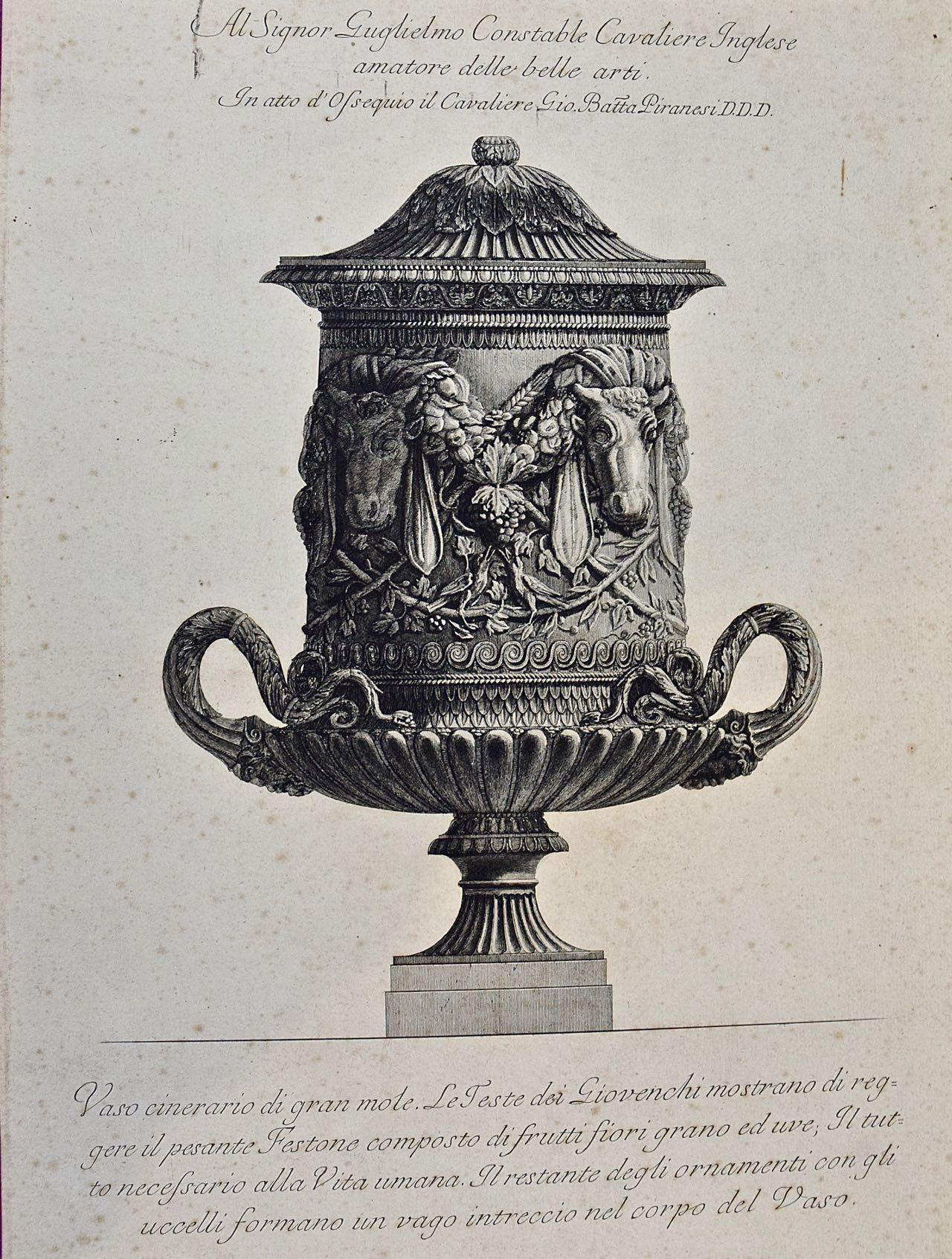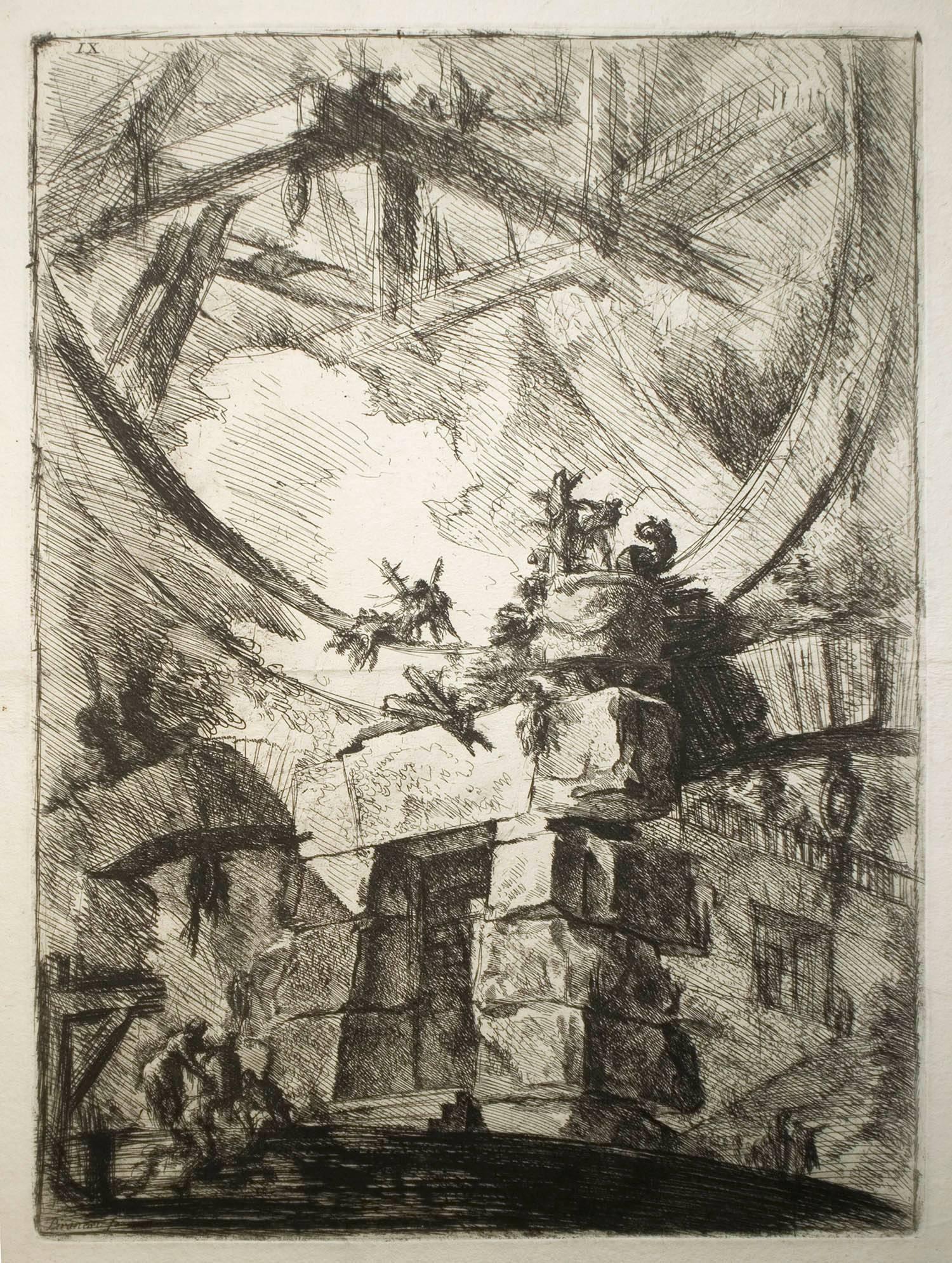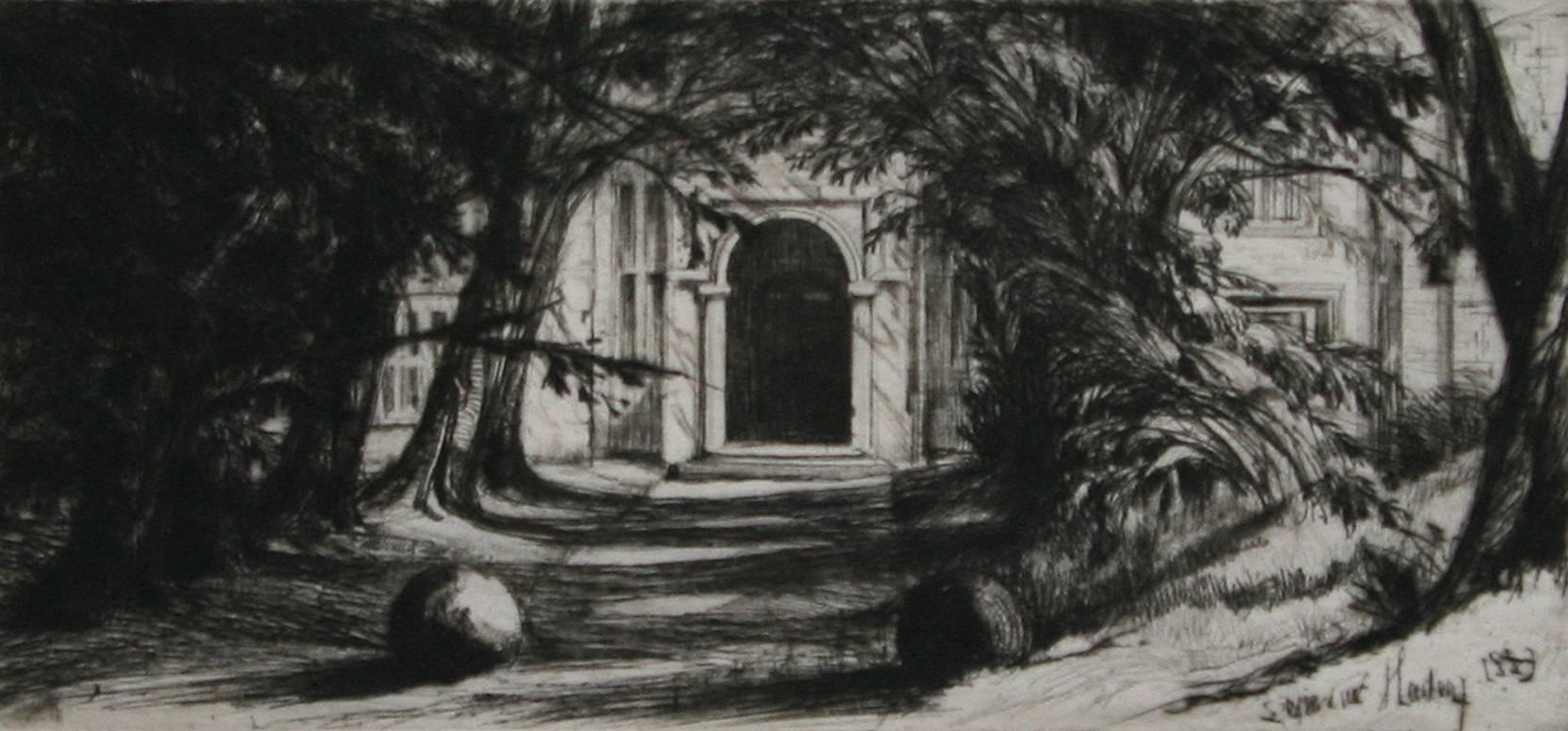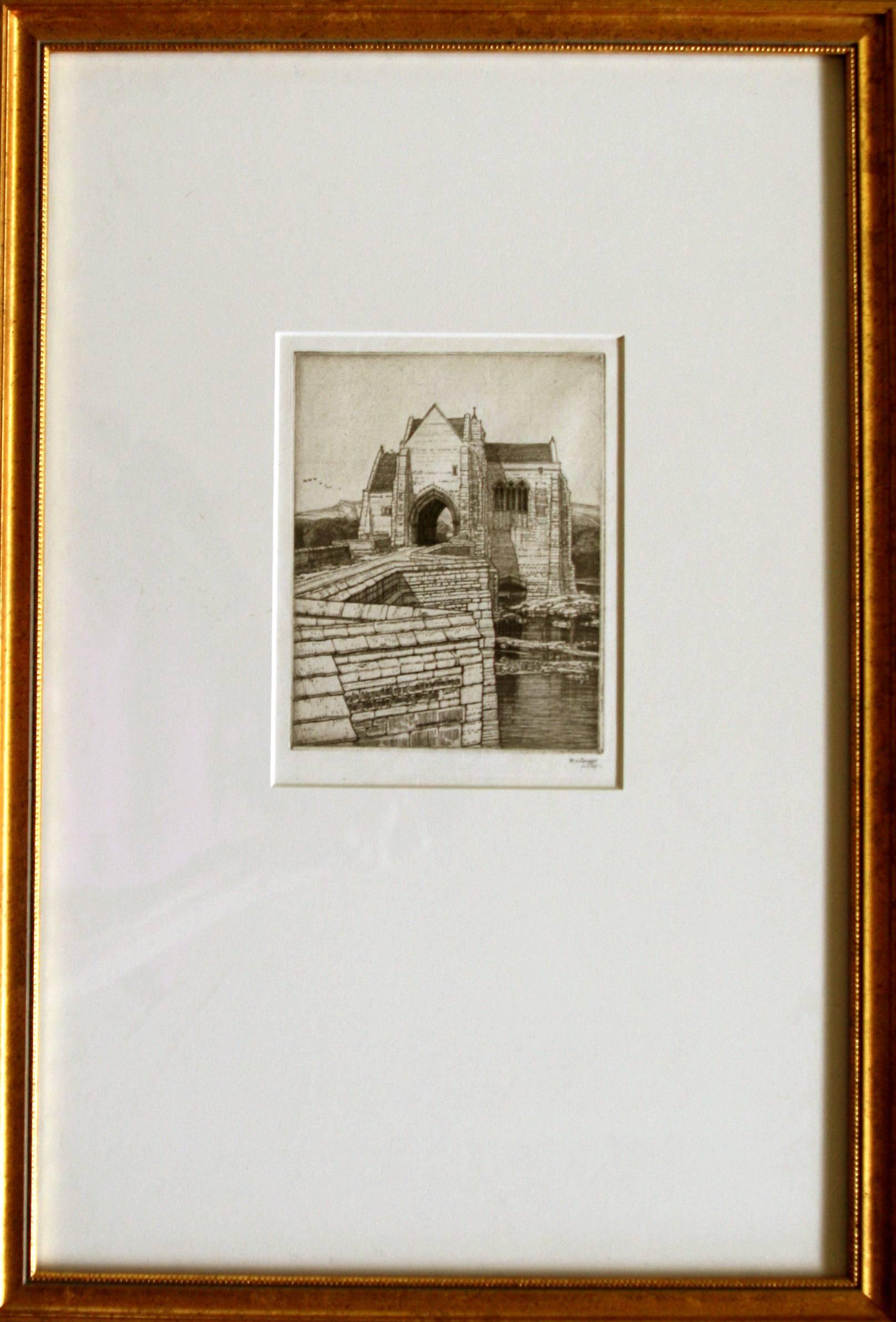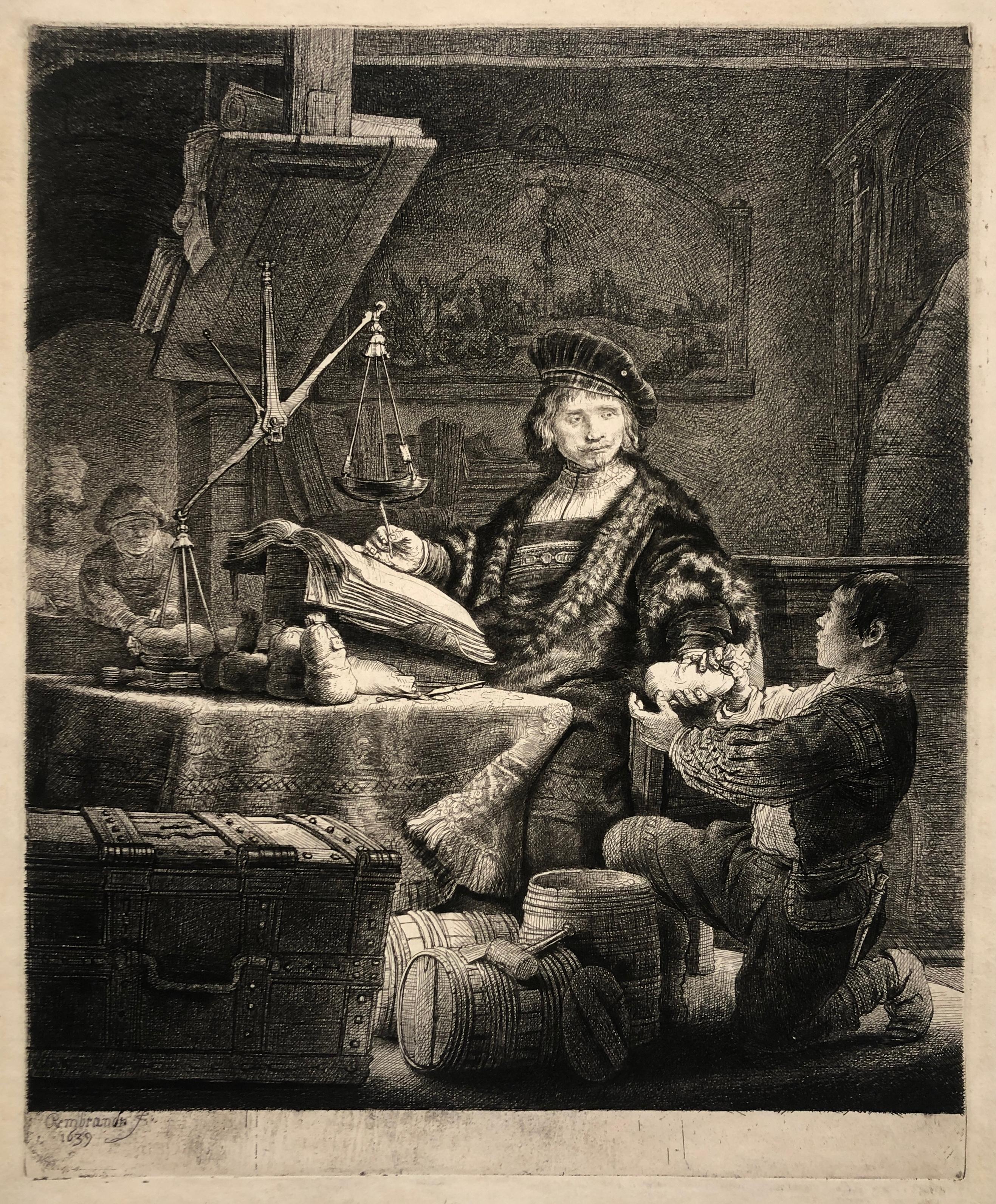Items Similar to The So-Called Tempio della Tosse, Near Tivoli. Interior Upright
Want more images or videos?
Request additional images or videos from the seller
1 of 9
Giovanni Battista PiranesiThe So-Called Tempio della Tosse, Near Tivoli. Interior Upright 1764
1764
About the Item
The So-Called Tempio della Tosse, Near Tivoli. Interior Upright (Veduta interna del Tempio della Tosse)
"Temple of the Cough"
Etching, 1764
Signed in the plate
From: Vedute di Roma, Plate 118
A Roman edition
Watermark: Fleur-de-Lys in a double circle
This building was depicted in a watercolor by J.M.W. Turner, 1819
Condition: Good/Excellent condition
Centerfold (as usual for Piranesi print from albums)
Bright snappy impression
Plate/Image size: 24 3/4 x 18 1/4 inches
Referrences: Focillon 775
Wilton_Ely 203
Hind 70 ii/V
"the so-called Tempio della Tosse (Temple of the Cough), believed to be the vestibule of a Roman villa. The ruin is situated near the Santuario di Ercole Vincitore (Sanctuary of Hercules Victor), formerly known as the Villa of Maecenas"
Courtesy: Tate
Regarding Vedute di Roma
"By 1747, Piranesi had begun work on the Vedute di Roma, and he continued to create plates for this series until he died in 1778. Piranesi’s Vedute, which overshadowed competitor’s views of Roman landmarks through compelling compositions, strong lighting contrasts, and dramatic presentation, shaped European conceptions of present day Rome. This influenced European thought to such an extent that Grand Tourists, who had come to know Rome through Piranesi’s prints, were recorded as being disappointed on their first encounter with the real thing.39 The views were intended as tourist souvenirs and, from their instant popularity, Piranesi had obviously judged the market well. His early sites include obvious popular sights, such as Piazza della Rotonda and the Sepolcro di Cecilia Metella. The first thirty-four views were published in a single volume and entitled Le Magnificenze di Roma. In his first views, the monument or subject was drawn from a distance so that it was clearly set in its context. The little figures present at the ground level are the everyday people and visitors in contemporary Rome. As represented in the “Veduta della Piazza della Rotonda,” Piranesi, clearly contorting perspective, etched an exaggerated and extended view of the Rotonda, unfocused on a specific aspect of the scene. His later views featured heavier line, a sublime eye, and more dramatic perspectives. They also specifically concentrate on a monument, like the “Veduta del Ponte Salario,” or ruin instead of portraying a sweeping view of Roman landscape. These changes could possibly be a response to market demand and what Grand Tourists wanted to see in their vedute, or it could be a personal style change as Piranesi became intrigued by the idea of the sublime. Nevertheless, these views of Rome firmly established Piranesi’s reputation and gave him the initial financial stability that enabled him to tackle grander themes. Moreover, Piranesi’s interest in ruins was genuine antiquarian desire to preserve and record.40 Piranesi was able to focus in on his awareness of what was noble and magnificent and gain a sense for the sublime in the architectural tradition of Rome. Piranesi’s lifelong obsession with architecture, past and present, was fundamental to his genius. His etched plates contained remarkable imagination and a practical understanding of ancient technology. They created a perception of antiquity lasting to our own time."
Courtesy Wellesley University
- Creator:Giovanni Battista Piranesi (1720-1778, Italian)
- Creation Year:1764
- Dimensions:Height: 24.75 in (62.87 cm)Width: 18.25 in (46.36 cm)
- Medium:
- Movement & Style:
- Period:1760-1769
- Condition:
- Gallery Location:Fairlawn, OH
- Reference Number:
About the Seller
5.0
Recognized Seller
These prestigious sellers are industry leaders and represent the highest echelon for item quality and design.
Platinum Seller
These expertly vetted sellers are 1stDibs' most experienced sellers and are rated highest by our customers.
Established in 1978
1stDibs seller since 2013
711 sales on 1stDibs
Typical response time: 1 hour
Associations
International Fine Print Dealers Association
- ShippingRetrieving quote...Ships From: Akron, OH
- Return PolicyA return for this item may be initiated within 10 days of delivery.
More From This SellerView All
- S. Paolo Fuori Le Mura (Vedute della Basilica di S. Paolo fuor della mura)By Giovanni Battista PiranesiLocated in Fairlawn, OHS. Paolo Fuori Le Mura (Vedute della Basilica di S. Paolo fuor della mura) Etching, 1748 From...Category
1740s Old Masters Interior Prints
MaterialsEtching
- St. Peter's Interior with the NaveBy Giovanni Battista PiranesiLocated in Fairlawn, OHSt. Peter's Interior with the Nave Veduta interna della Basilica di S. Pietro in Vaticano Etching, 1748 Signed in the plate From: Vedute di Roma, Plate 5 An early Roman...Category
1740s Old Masters Interior Prints
MaterialsEtching
- La Negresse (The Negress)By Louis LegrandLocated in Fairlawn, OHLa Negresse (The Negress) Etching & drypoint, 1909 Unsigned (as issued in the portfolio) From the album "Les Bars" (8 plates plus cover illustration) Editi...Category
Early 1900s Art Nouveau Interior Prints
MaterialsEtching
- Gaiety BurleskBy Reginald MarshLocated in Fairlawn, OHGaiety Burlesque Etching, 1930 Unsigned (as usual for the Whitney edition); Numbered in pencil lower left; Blind stamp of the Whitney Museum (WM) lower right Edition: 114, regular ed...Category
1930s American Modern Interior Prints
MaterialsEtching
- The Art of Conversation (Three characters on...)By Marcel GromaireLocated in Fairlawn, OHThe Art of Conversation (Three characters on...) Etching, 1958 Signed in pencil lower right: “Gromaire” (see photo) Edition: 110 (18/110) see photo Printed on RIVES paper Publisher: ...Category
1950s Cubist Interior Prints
MaterialsEtching
- The Woman and the StreetBy Marc ChagallLocated in Fairlawn, OHThe Woman and the Street Etching, 1927-1930 Signed in the plate lower right corner (see photo) From: The Fables of La Fontaine, Plate 84 From the deluxe portfolio edition of 40 examples, printed on japan nacré paper Printed by Maurice Potin, 1927-1930 Published by Tériade, éditeur, Paris, 1952 Reference: Johnson 174 Condition: Tape stain top center recto from pervious hinging. Image/Plate size: 11 3/4 x 9 1/2 inches Sheet size: 15 1/8 x 11 1/8 inches The Women and the Secret There's nothing like a secret weighs; Too heavy 'tis for women tender; And, for this matter, in my days, I've seen some men of female gender. To prove his wife, a husband cried, (The night he knew the truth would hide,) 'O Heavens! What's this? O dear...Category
1920s French School Prints and Multiples
MaterialsEtching
You May Also Like
- Ancient Roman Medici Marble Vase: An 18th Century Etching by PiranesiBy Giovanni Battista PiranesiLocated in Alamo, CAThis large 18th century etching by Giovanni Battista Piranesi is entitled "Vaso antico di Marmo adornato di eccellenti Sculture si nella parte anteriere che nell' opposta, le quail r...Category
1770s Old Masters Figurative Prints
MaterialsEtching
- Ancient Roman Marble Vase: 18th C. Piranesi Etching Vaso Cinerario di Gran MoleBy Giovanni Battista PiranesiLocated in Alamo, CA"Vaso Cinerario di Gran Mole. Le Teste dei Giovenchi mostrano di reggere it pesante Festone composto di Frutti Fiori Grans ed use. Il tuto Necefsario all Vita Umana. Il Restante degl...Category
1760s Old Masters Figurative Prints
MaterialsEtching
- The Giant Wheel (Carceri IX), (2nd State)By Giovanni Battista PiranesiLocated in Chicago, ILThis is a second state impression from three states.Category
Mid-18th Century Old Masters Interior Prints
MaterialsEngraving, Etching
- Mytton HallBy Sir Francis Seymour Haden, R.A.Located in Storrs, CTMytton Hall. 1859. Etching and drypoint. Schneiderman catalog 19 state .iii/v. 4 13/16 x 10 5/16 (sheet 5 3/4 x 10 15/16). As published in Études à l'eau-forte XXIV. Illustrated: Guichard, British Etchers, 1850-1940. An extremely rich impression printed on fine laid paper. Signed in the plate. Housed in a 16 x 20-inch archival mat. Mytton Hall is a fifteenth century mansion house situated on the River Ribble, at Whalley near Blackburn, Lancashire. Haden used to stay there when he went salmon fishing. R. Gutekunst, the dealer who inherited the rights to sell all of Francis Seymour Haden's remaining prints upon his death, noted on the front of his catalogue in July 1911: "It may be useful to add that those impressions of Sir Seymour Haden's early and rare etchings, which were published in portfolio form in Paris in 1865-66, under the title Études à l'eau-forte have, with the exception of one or two sets, never been signed in autograph by Sir Seymour, and do not, of course, bear any stamp of any kind." Although Gutekunst had impressions of the majority of Haden's works for sale, he had no remaining impressions of Mytton Hall. Henry Taylor...Category
Mid-19th Century Old Masters Landscape Prints
MaterialsDrypoint, Etching
- St. Botolph's Bridge (No. 1).By Frederick Landseer Griggs, R.A., R.E.Located in Storrs, CTSt. Botolph's Bridge (No. 1). 1917. Etching. Comstock catalog 19 state iv. 5 3/4 x 4 1/2 (sheet 9 3/8 x 8 5/8). Edition 50 in this state (total 70 proofs in 4 states.) A rich impres...Category
Early 20th Century Old Masters Landscape Prints
MaterialsEtching
- Jan Uytenbogaert, The GoldweigherBy Rembrandt van RijnLocated in Boston, MABartsch 281, Hind 167 iii/III, Nowell-Usticke 281, iii/III. A fine impression, with burr, as retouched by Baillie in 1792. With an unidentified collectors stamp, verso.Category
17th Century Old Masters Figurative Prints
MaterialsDrypoint, Etching
Recently Viewed
View AllMore Ways To Browse
Piranesi Etchings Rome
Alice Neel On Sale
Calvin Klein 1995
Caridad De Cobre
Carl Ivar Gilbert
Carter Holman
Charlie Pachter
Cheetah Lamps
Chester River Living
Chromatique Sofa
Clouds Adrift
Constance And Sons Auctions
Crown Of Glory Tunde Bakare
Dale Chihuly Ikebana
Danilo Donati
David Dornan
David Inshaw
Death Of Demosthenes

